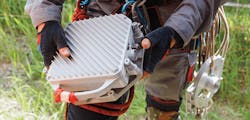Fall Prevention Safety Resources for the Communication Tower Industry
Early this spring, companies, workers, and stakeholders involved in the communication tower industry were active participants in the Occupational Safety & Health Administration’s (OSHA) National Safety Stand-Down to Prevent Falls in Construction. The purpose of this annual Safety Stand-Down is to raise awareness of preventing fall hazards in construction.
According to OSHA (www.osha.gov), fatalities caused by falls from elevation continue to be a leading cause of death for workers in the construction trades, accounting for 337 of the 874 construction fatalities recorded in 2014 (Bureau of Labor Statistics preliminary data). Additionally, fall prevention safety standards were among the top 10 most frequently cited OSHA standards during fiscal year 2014.
For companies and workers directly involved in working at heights on communication structures, falls from heights continue to represent one of the frequently encountered hazards the workforce is confronted with on a daily basis. Some examples of other hazards associated with communication tower work include inclement weather, falling object hazards, equipment failure, structural collapse, and electrical hazards.
Fortunately, the wireless infrastructure industry is in a strong position to mitigate and eliminate communication tower falls. There is an abundance of fall protection standards, training programs, and safety resources available to the industry’s workforce to ensure that all elevated communication tower work is done safely. Additionally, the industry has come together on some exciting new initiatives that will also help enhance tower technician safety when working at heights.
Fall Protection Standards
It is critical that tower construction and maintenance companies and workers adhere to all of the fall protection standards governing the industry. Simply put, if the fall protection standards are followed, working at heights is a safe endeavor. The following is a listing of the fall protection standards that should be adhered to in order to ensure a safe working environment for the industry’s workforce.
NATE Tower Climber Training Standard — 4th Edition
The National Association of Tower Erectors (NATE) Tower Climber Fall Protection Training Standard (CTS) 4th edition is available to the industry in order to better facilitate training and improve safety in the industry.
The NATE CTS outlines individual standards for varying levels of tower climber expertise: Authorized Climber, Authorized Rescuer, Competent Climber and Competent Rescuer. The document also contains a Course Training Plan to demonstrate how to implement and utilize the NATE CTS. The CTS is the Association’s signature safety resource and provides one more tool in the toolbox to ensure that climber training is consistent regardless of who is conducting the training.
OSHA Safety and Health Regulations for Construction — 1926 Subpart M
1926 Subpart M sets forth the requirements and criteria for fall protection in construction workplaces. Subpart M covers information including the duty to have fall protection, fall protection systems criteria and practices, and fall protection training requirements. Additionally, 1926 Subpart M includes appendix resources devoted to sample fall protection plans, positioning device systems, personal fall arrest systems, guardrail systems, and determining
roof widths.
ANSI/ASSE Z359 Fall Protection Code — Version 3.0
The American National Standards Institute (ANSI)/American Society of Safety Engineers (ASSE) Z359 Fall Protection Code package should be adhered to by all elevated workers and is a comprehensive fall protection standard that includes the following information:
• Definitions and Nomenclature Used for Fall Protection and Fall Arrest
• Safety Requirements for Personal Fall Arrest Systems, Subsystems and Components
• Minimum Requirements for a Comprehensive Managed Fall Protection Program
• Safety Requirements for Positioning and Travel Restraint Systems
• Safety Requirements for Assisted-Rescue and Self-Rescue Systems, Subsystems and Components
• Specifications and Design Requirements for Active Fall Protection Systems
• Qualification and Verification Testing of Fall Protection Products
• Safety Requirements for Full Body Harnesses
• Connecting Components for Personal Fall Arrest System
• Personal Energy Absorbers and Energy Absorbing Lanyards
• Safety Requirements for Self-Retracting Devices for Personal Fall Arrest and Rescue Systems
• Safety Requirements for Single Anchor Lifelines and Fall Arresters for Personal Fall Arrest and Rescue Systems
A10.48 Standard — Criteria for Safety Practices with the Construction, Demolition, Modification and Maintenance of Telecommunications Structures (Under Development)
This A10.48 Tower Safety Standard is currently under development and upon completion will be the first standard that encompasses the entire tower construction, service, and maintenance industry. This A10.48 Tower Safety Standard will include an entire chapter devoted specifically to fall protection.
In addition to adherence to fall protection standards, there are many outstanding training options available to today’s elevated workforce that help ensure fall protection safety. Today’s workers can receive training in fall protection and rescue from private training companies, employer training programs, apprenticeship programs, and community college offerings. Proper training in fall protection and rescue is absolutely imperative prior to work commencing at communication tower-sites.
Personal Protective Equipment (PPE) and Personal Fall Arrest Systems (PFAS) are also vital components of fall protection safety. This equipment should be inspected by tower technicians prior to each use to ensure that it is in satisfactory condition and therefore deemed safe to utilize when working on a communication tower. All tower industry personnel and stakeholders should utilize an equipment checklist before each use to ensure that a culture of fall protection safety permeates throughout each worker.
Manufacturing and Engineering Initiatives
Manufacturers and industry experts have met previous challenges facing our industry, and there are several current industry led initiatives taking place in this arena to help create a safer environment for tower technicians who work at elevation.
In October of 2016, the industry will be conducting a Step Bolt testing event with structural manufacturers to determine the strength of 5/8" step bolts on monopole structures. This is an important initiative as monopole structures are considered the most difficult communication towers to climb. It is imperative that the step bolts manufactured on monopole towers are of adequate strength to ensure the safety of the elevated workforce. The data and key findings collected from this testing event will be utilized to assist structural manufacturers and potentially be placed as a requirement in the Telecommunications Industry Association (TIA) 222 Rev. H Structural Standard that is currently under development.
Representatives consisting of industry associations, wireless carriers, tower companies, contractor companies, training companies, and equipment manufacturers have also recently established a working group to study the critical role safety climb equipment plays in protecting tower climbers. The goal of the working group is to help ensure safety climb systems are installed, maintained, and inspected properly, and in accordance with existing standards.
The formal working group has established a plan to create specific industry standards, as well as a common vocabulary for safety climb systems used in the installation, maintenance, and inspection of safety climb systems. The working group also will work to clarify the requirements necessary for competent contractors to properly inspect these safety climb systems prior to considering their use as part of the fall protection plan for the Scope of Work (SOW) on a telecommunications site, as well as the inspection of this equipment as an appurtenance on the structures.
UAS Technology
Unmanned Aerial Systems (UAS) technology is also currently in the early stages of integration into the wireless infrastructure industry. UAS technology will play a valuable supplemental role in enhancing safety and quality in the industry as the regulatory environment surrounding the commercial use of UAS technology gains clarity. UAS technology will never serve as a replacement for the tower technician workforce but there is an obvious supplemental benefit related to UAS utilization when working on communication structures. The safe and appropriate use of UAS into the industry can be used for such functions as pre-site inspections and close-out photos on the tower. These practical functions can serve to reduce the number of times a worker would have to scale a tower during a particular job, therefore helping serve to mitigate the potential of falls from heights.
Safety Is Everything
Communication tower contractors and the technicians they employ are the backbone of the wireless infrastructure industry. The LTE installations, network upgrades, and broadband deployments they perform on a daily basis, are having a transformational impact on virtually all sectors of our economy — from health care to finance, energy to manufacturing, higher education to agriculture, military to public safety, and everything in between.
At the same time, as new technologies come on the scene, the industry is evolving to meet the global connectivity needs and our society’s unquenchable thirst for data consumption. These companies will continue to play a vital role in building/equipping both the current networks and the future infrastructure that will be necessary to enable emerging technologies such as the Internet of Things and 5G.
This important work is essential, and the industry continues to remain vigilant and committed to ensure the fall protection of our most precious resource: the men and women who make up our workforce.
About the Author

